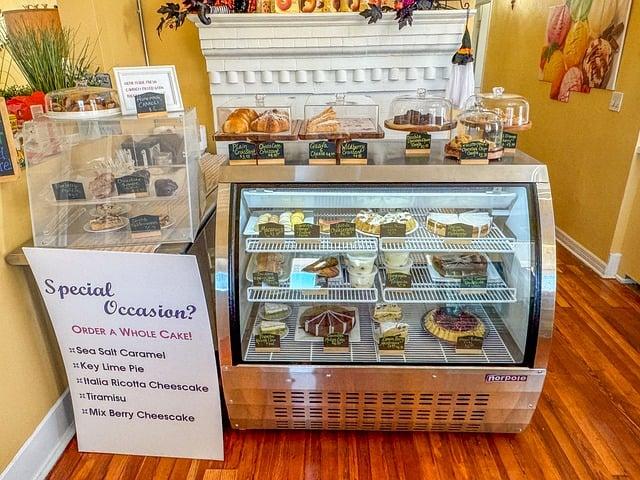In a quaint village nestled in the heart of Provence, a tradition blossomed long ago. Each Christmas, families gathered to celebrate the birth of Christ with a feast that included 13 desserts, symbolizing Jesus and his 12 apostles. The table overflowed with sweet delights: nougat, candied fruits, and rich pastries, each representing abundance and gratitude. As the villagers savored each bite, laughter and stories filled the air, weaving a tapestry of joy and togetherness. This cherished custom transformed a simple meal into a celebration of faith, family, and the sweetness of life.
Table of Contents
- The Tradition Behind the Thirteen Desserts of Christmas
- Exploring the Symbolism and Significance of Each Sweet Treat
- Crafting Your Own Thirteen Desserts: Tips and Recipes
- Celebrating Diversity: How Different Cultures Interpret the Thirteen Desserts
- Q&A

The Tradition Behind the Thirteen Desserts of Christmas
The custom of serving thirteen desserts during the Christmas season is steeped in rich history and symbolism, particularly in the Provence region of France. This delightful tradition is believed to represent the twelve apostles and Christ, making it a significant part of the festive celebration. Each dessert carries its own meaning and is often made from local ingredients, showcasing the region’s culinary heritage. Families gather to prepare these sweets, creating a sense of community and continuity as they pass down recipes through generations.
Among the array of desserts, you might find **bûche de Noël** (Yule log), **calissons** (almond candies), and **nougat**. Each of these treats not only tantalizes the taste buds but also tells a story of the season. The variety of flavors and textures reflects the abundance of the harvest and the joy of sharing with loved ones. As families indulge in this sweet feast, they celebrate not just the holiday but also the bonds that tie them together, making the thirteen desserts a cherished ritual that transcends mere culinary delight.

Exploring the Symbolism and Significance of Each Sweet Treat
Each of the thirteen desserts served during Christmas dinner carries its own unique symbolism, reflecting the rich tapestry of cultural traditions and beliefs. For instance, **bûche de Noël**, a traditional Yule log cake, represents the warmth and light of the holiday season, evoking the ancient custom of burning a log to ward off winter’s chill. Similarly, **calissons**, almond-shaped candies from Provence, symbolize the sweetness of life and the joy of family gatherings. The inclusion of **nougat**, with its layers of nuts and honey, signifies the harmony and unity of the family, while **pannetone**, a fluffy Italian bread, embodies the hope for prosperity in the coming year.
Moreover, the variety of desserts serves to honor the twelve apostles and the birth of Christ, with each treat representing a different aspect of faith and community. **Tarte aux fruits**, a colorful fruit tart, reflects the abundance of nature and the blessings of the harvest, while **pain d’épices**, a spiced gingerbread, connects to the warmth of home and the comfort of shared traditions. The **chocolates** and **candied fruits** not only delight the palate but also symbolize the richness of life and the sweetness of togetherness. Each dessert, therefore, is not merely a treat but a meaningful representation of the values and stories that bind families and communities during this festive season.

Crafting Your Own Thirteen Desserts: Tips and Recipes
Creating your own version of the traditional thirteen desserts can be a delightful and rewarding experience. To start, consider incorporating a mix of flavors and textures that reflect your personal taste and cultural background. **Classic options** like bûche de Noël (Yule log) and pannettone can be complemented by **regional specialties** such as pudding or fruitcake. Don’t shy away from experimenting with **modern twists**—think of adding a touch of spice to your chocolate mousse or infusing your panna cotta with seasonal fruits. The key is to balance the richness of desserts with lighter options, ensuring a harmonious spread that invites guests to indulge without feeling overwhelmed.
When it comes to presentation, creativity is essential. Arrange your desserts on a large platter or tiered stand to create an eye-catching display. Use **festive garnishes** like edible flowers, candied fruits, or sprigs of mint to add color and vibrancy. Additionally, consider offering a variety of **serving styles**—some desserts can be served in individual portions, while others can be shared family-style. To enhance the experience, pair each dessert with a complementary beverage, such as spiced cider or a rich dessert wine. By thoughtfully curating your thirteen desserts, you not only honor tradition but also create a memorable culinary experience for your holiday gathering.

Celebrating Diversity: How Different Cultures Interpret the Thirteen Desserts
Throughout the world, the tradition of serving thirteen desserts during Christmas dinner is a delightful tapestry woven from various cultural threads. In regions like Provence, France, this custom is steeped in history and symbolism, representing the twelve apostles and Christ. Each dessert carries its own significance, often reflecting local ingredients and culinary practices. For instance, the calissons, a sweet almond paste delicacy, showcases the region’s rich agricultural heritage, while nougat embodies the festive spirit with its chewy texture and nutty flavors. The diversity of these desserts not only tantalizes the taste buds but also serves as a reminder of the rich cultural narratives that accompany each bite.
In contrast, other cultures interpret the thirteen desserts through their unique lenses, infusing the tradition with local flavors and customs. In some Italian households, the concept of the thirteen desserts transforms into a vibrant display of panettone, struffoli, and torrone, each symbolizing abundance and joy. Meanwhile, in Spanish-speaking countries, the emphasis may shift towards buñuelos and turrón, celebrating the festive season with a blend of textures and tastes that reflect the region’s culinary identity. This rich variety not only highlights the importance of family and community during the holiday season but also showcases how a single tradition can evolve and adapt, creating a mosaic of flavors that honors both heritage and innovation.
Q&A
-
What is the significance of the 13 desserts?
The tradition of serving 13 desserts at Christmas dinner symbolizes the Last Supper, representing Jesus and his 12 apostles. Each dessert reflects the richness of the season and the abundance of blessings.
-
Where did the tradition originate?
This delightful custom hails from the Provence region of France, where families gather to celebrate Christmas with a feast that showcases local flavors and festive spirit.
-
What types of desserts are typically included?
The 13 desserts can vary by family and region but often include:
- Nougat
- Calissons
- Fruit (like figs and dates)
- Cookies and pastries
- Chocolate
-
Is there a specific order to serve the desserts?
While there is no strict order, the desserts are usually presented together at the end of the meal, allowing guests to sample a variety of flavors and textures, celebrating the joy of the season.
the tradition of serving 13 desserts at Christmas dinner is a delightful blend of history, symbolism, and community. Each sweet treat tells a story, reminding us that the holiday season is about sharing joy, love, and cherished moments with those we hold dear.




